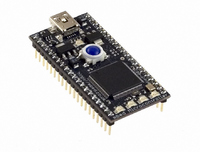OM11043 NXP Semiconductors, OM11043 Datasheet - Page 24

OM11043
Manufacturer Part Number
OM11043
Description
DEVELOPMENT BOARD LPC1768 MBED
Manufacturer
NXP Semiconductors
Series
mbedr
Type
MCUr
Specifications of OM11043
Contents
Board and software
Development Tool Type
Hardware / Software - Eval/Demo Board
Kit Contents
Board Cable Docs
Mcu Supported Families
LPC1000
Tool / Board Applications
General Purpose MCU, MPU, DSP, DSC
Silicon Manufacturer
NXP
Core Architecture
ARM
Core Sub-architecture
Cortex - M3
Silicon Core Number
LPC17xx
Silicon Family Name
LPC17xx
Lead Free Status / RoHS Status
Lead free / RoHS Compliant
For Use With/related Products
LPC1768
Lead Free Status / RoHS Status
Lead free / RoHS Compliant
Other names
568-4916
Available stocks
Company
Part Number
Manufacturer
Quantity
Price
NXP Semiconductors
LPC1769_68_67_66_65_64_63
Product data sheet
7.12.1.1 Features
7.12.1 USB device controller
7.12 USB interface
Remark: The USB controller is available as device/Host/OTG controller on parts
LPC1769/68/66/65 and as device-only controller on part LPC1764.
The Universal Serial Bus (USB) is a 4-wire bus that supports communication between a
host and one or more (up to 127) peripherals. The host controller allocates the USB
bandwidth to attached devices through a token-based protocol. The bus supports hot
plugging and dynamic configuration of the devices. All transactions are initiated by the
host controller.
The USB interface includes a device, Host, and OTG controller with on-chip PHY for
device and Host functions. The OTG switching protocol is supported through the use of an
external controller. Details on typical USB interfacing solutions can be found in
Section
The device controller enables 12 Mbit/s data exchange with a USB Host controller. It
consists of a register interface, serial interface engine, endpoint buffer memory, and a
DMA controller. The serial interface engine decodes the USB data stream and writes data
to the appropriate endpoint buffer. The status of a completed USB transfer or error
condition is indicated via status registers. An interrupt is also generated if enabled. When
enabled, the DMA controller transfers data between the endpoint buffer and the on-chip
SRAM.
•
•
•
•
•
•
Enhanced Ethernet features:
– Receive filtering.
– Multicast and broadcast frame support for both transmit and receive.
– Optional automatic Frame Check Sequence (FCS) insertion with Cyclic
– Selectable automatic transmit frame padding.
– Over-length frame support for both transmit and receive allows any length frames.
– Promiscuous receive mode.
– Automatic collision back-off and frame retransmission.
– Includes power management by clock switching.
– Wake-on-LAN power management support allows system wake-up: using the
Physical interface:
– Attachment of external PHY chip through standard RMII interface.
– PHY register access is available via the MIIM interface.
Fully compliant with USB 2.0 specification (full speed).
Supports 32 physical (16 logical) endpoints with a 4 kB endpoint buffer RAM.
Supports Control, Bulk, Interrupt and Isochronous endpoints.
Scalable realization of endpoints at run time.
Redundancy Check (CRC) for transmit.
receive filters or a magic frame detection filter.
14.1.
All information provided in this document is subject to legal disclaimers.
Rev. 6.01 — 11 March 2011
LPC1769/68/67/66/65/64/63
32-bit ARM Cortex-M3 microcontroller
© NXP B.V. 2011. All rights reserved.
24 of 79
















